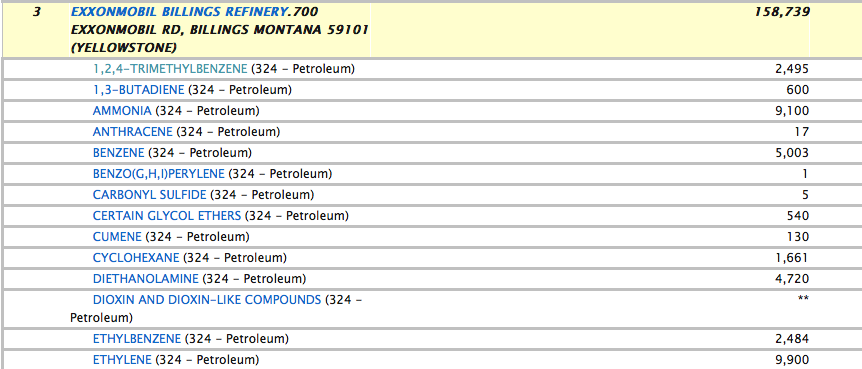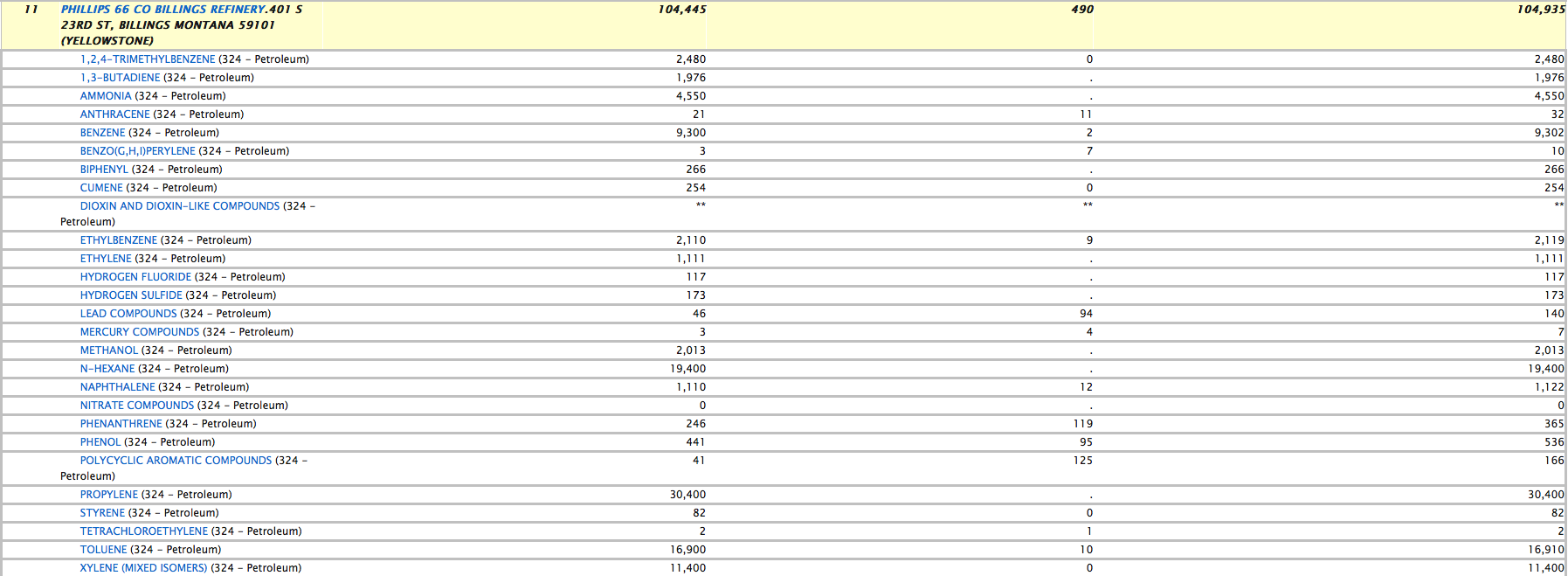What really comes out of the oil refinery stacks in Billings? Don’t ask the Billings Gazette.

According to an article in the Billings Gazette entitled “Is the Big Sky blowing smoke?” only water vapor comes out of the stacks at the three oil refineries around Billings and the sugar beet factory.
Ryan Wegner, manager of finance and public affairs at Phillips 66 Billings Refinery, explains why anyone who says the Big Sky is filled with anything other than steam is just blowing smoke.
“Many folks see these plumes from our facility and believe they are something other than what they actually are — steam. In the process of refining oil into gasoline and diesel fuel, much heat is generated which then needs to be dissipated through heat exchangers,” he said. “We use a number of different types of heat exchangers at the refinery, and the white plumes rising from the refinery are steam from cooling towers.”
As someone who grew up in Billings and experienced the very well publicized air quality problems from those refineries and the now-shuttered coal-fired power plant, I was taken aback by the article. And you should be too because there are things called facts. The reporter and her editor apparently didn’t think it was necessary to do research on what comes out of those stacks.
Yes, the white puffy clouds are steam but there are dozens of toxic chemicals, gases and heavy metals in that water vapor that you can’t see.
What gets released into the air from the Billings oil refineries?
Luckily, because of our environmental regulations we don’t have to guess what is coming out of the stacks. Each oil refinery is required to report their emissions to the DEQ and the EPA. Setting aside for a moment the problems with self reporting let’s just look at what we know is being released into the air.
There are dozens and dozens of chemicals, gases and some heavy metals. In the chemical and gas category, the Billings’ refineries release naphthalene, toluene, ammonia, anthracene, formaldehyde, vinyl chloride, hydrogen cyanide, carbon dioxide (CO2), sulphur dioxide (SO2), nitrogen oxide (NO2), carbon monoxide, methane, dioxins, hydrogen fluoride, chlorine and benzene. In the category of heavy metals we have lead, mercury, nickel compounds and zinc. These chemicals and gases are not benign. Most of them are known or suspected to cause cancer, birth defects, and seriously impact the environment.
SO2 and NOx have numerous adverse effects on human health and are significant contributors to acid rain, smog and haze. SO2 can pose respiratory illness risks, particularly to children, seniors and people with asthma. And it is no surprise to anyone who has lived in Billings for awhile that we have dealt with unsafe levels of SO2 emissions for decades from multiple sources. Refineries also emit greenhouse gases that contribute to climate change, as well as fugitive volatile organic compounds, known as VOCs.
As the article correctly pointed out, the releases of certain amounts of these chemicals and heavy metals are permitted under the Clean Air Act and other air quality regulations. What Billings residents should know is that how these exposure levels are determined is a highly controversial, political and uncertain process.
Regulatory agencies like the EPA and OSHA are charged with setting “safe” exposure levels for some chemicals by testing for effects at high concentrations and then they use statistical extrapolation and determine levels they deem safe for humans to be exposed to. However, study after study in communities that are around oil refineries have shown a higher incidence of certain types of cancer and respiratory problems.
Health impacts from living around oil refineries
According to the Environmental Health Journal, a peer reviewed scientific journal, the method used to develop safe exposure levels assumes that “if exposure goes up so do effects and if exposure goes down so will effects.” However, recent studies have found that chemicals do not always follow this assumption and they may cause different effects on people at higher and lower levels.
Researchers in Sweden studied one of the largest and most modern oil refineries in Europe called Lysekil. They found that during the past 10 years, communities downwind of the refinery had twice as many cases of leukemia as would be expected based on the refinery’s low emissions.
In the peer reviewed journal Cancer published by the American Cancer Society, a study found a higher cancer incidences rate in regions near refineries and plants that release benzene. There is a fascinating investigative report done by the Pulitzer prize winning Center for Public Integrity about the oil industry’s attempt to downplay the impacts of benzene on human health. In 2015, the Exxon refinery released over 5,000 pounds of benzene, the Phillips 66 refinery in Laurel released 9,300 pounds of it and the CHS refinery released 3,813 pounds.
In the American Journal of Public Health researchers conducted a systematic review of 94 studies that examined residential proximity to environmental hazards, including oil refineries, in relation to adverse reproductive outcomes, childhood cancer, respiratory and cardiovascular conditions and other health problems.
In the 12 studies they reviewed on respiratory illness they found, “residential proximity to both stationary sources of air pollution (industries covered under the Toxic Release Inventory, National Emission Inventory, hazardous air pollutants, petroleum refineries, etc.), and, with a few exceptions, heavily trafficked roads, was significantly associated with asthma hospitalizations.”
In another study in Environmental Health Perspective researchers found that short-term episodes of increased SO2 exposures from refinery stack emissions were associated with a higher number of asthma episodes in nearby children.
There are other types of emissions from the refineries the reporter failed to mention that are extremely concerning to most people that study pollution from oil refineries. Flaring of gases results in emissions of SO2, greenhouse gases, VOCs and hazardous air pollutants. There are also fugitive emissions of VOCs that can result from leaking valves and pumps. Those fugitive emissions can result in numerous health effects, including eye, nose and throat irritation, headaches, loss of coordination, nausea and damage to liver, kidney and the central nervous system.
At the end of the Billings Gazette article was this sentence,
“It’s a common misconception that the exhaust from the refineries and sugar beet factory are harming the environment.”
No, this wasn’t a quote from a public affairs person from the refinery, it was written by the reporter. The Billings Gazette needs to run a big correction on this puff piece. I don’t expect a commentary on the pollution that comes out of the refineries but I do expect the Billings Gazette to report the facts, not spin from public affairs people.
If you are interested in the details of what each refinery said they emitted in 2015, I have included screenshots from the EPA’s Toxic Release Inventory. Please click on each table to increase the size. UPDATE: On Monday April 3, Billings Gazette ran an Op-Ed by Eileen Morris, a long time Billings resident whose friend died from an asthma attack caused by SO2 pollution from the refineries.
Exxon Refinery – 2015 TRI Report. EPA’s Toxic Release Inventory
Phillips 66 – 2015 TRI Report.
CHS Laurel Refinery – 2015 TRI Report.
And since the Sugar Beet Factory was also a part of the story, here is what they reported releasing in 2015.





Appreciate your reporting this. I am concerned that under the new EPA chief the “facts” that will be sent out will be even more suspect than the self reporting issue you raised. Not a great time for the environment or wildlife right now….
You have done a public service by alerting folks to the “scrubbed” information put out by industry and their lapdogs. Good job on researching the issue and providing substantiation of your findings. If I lived in, or downwind from, Billings, I sure would want to know what was in the air I breathe.
There may be mental health effects as well.
https://www.theguardian.com/environment/2016/jun/13/air-pollution-linked-to-increased-mental-illness-in-children
Just now, in ND, a refinery incident: “Tesoro says although this is out of the ordinary, it looks worse than it is and no one is in danger.”
http://www.myndnow.com/news/bismarck-news/mandan-tesoro-refinery-power-outage-causes-heavy-flare-smoke/683978011
Here, in “over-regulated” California, a Bay Area refinery released hydrofluoric acid, but, told locals that it would just make the air smell bad.
If you can smell that acid, it’s into dangerous amounts!